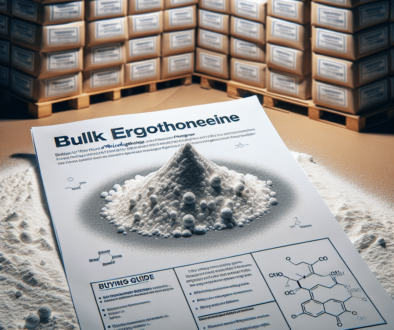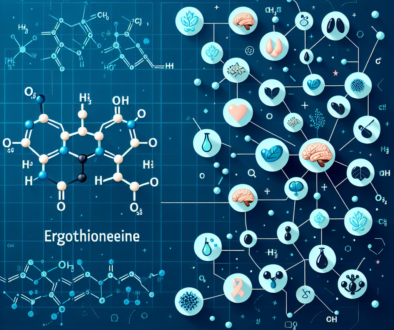L-(+)-Ergothioneine(EGT) Pathophysiology: Exploring Disease Connections
-
Table of Contents
- Ergothioneine Pathophysiology: Unveiling Its Role in Disease
- Understanding L-(+)-Ergothioneine (EGT)
- The Antioxidant Properties of EGT
- EGT and Neurodegenerative Diseases
- EGT and Cardiovascular Health
- EGT and Inflammation
- EGT and Cancer
- EGT and Aging
- Conclusion: The Potential of EGT in Disease Prevention and Treatment
- Discover ETprotein’s High-Quality L-(+)-Ergothioneine Products
Ergothioneine Pathophysiology: Unveiling Its Role in Disease

L-(+)-Ergothioneine (EGT) is a naturally occurring amino acid derivative that has been the subject of increasing scientific interest due to its potential role in various physiological and pathophysiological processes. This article explores the connections between EGT and disease, examining how this compound may influence health and disease states.
Understanding L-(+)-Ergothioneine (EGT)
Before delving into the pathophysiological aspects of EGT, it is essential to understand what this compound is and where it comes from. EGT is a thiourea derivative of histidine, containing a sulfur atom on the imidazole ring. This unique structure endows EGT with potent antioxidant properties, protecting cells from oxidative damage. It is primarily found in certain mushrooms, black and red beans, and some meat products.
The Antioxidant Properties of EGT
One of the most well-documented roles of EGT is its function as an antioxidant. EGT scavenges reactive oxygen species (ROS) and reactive nitrogen species (RNS), which are byproducts of normal cellular metabolism that can cause significant damage to cellular components if not adequately controlled. By neutralizing these harmful compounds, EGT helps to maintain cellular integrity and function.
- Protection against DNA damage
- Preservation of cell membrane integrity
- Stabilization of protein structures
EGT and Neurodegenerative Diseases
Neurodegenerative diseases, such as Alzheimer’s and Parkinson’s, are characterized by the progressive loss of neuronal structure and function. Oxidative stress is a common feature in these diseases, and EGT’s antioxidant capabilities suggest a potential therapeutic role.
- In Alzheimer’s disease, EGT may help to prevent the oxidation of neuronal cells and reduce the formation of beta-amyloid plaques.
- In Parkinson’s disease, EGT could protect dopaminergic neurons from oxidative damage and mitigate the effects of neurotoxins that contribute to the disease’s progression.
EGT and Cardiovascular Health
Oxidative stress is also a contributing factor to cardiovascular diseases. EGT’s ability to protect against lipid peroxidation—a process that can lead to atherosclerosis—positions it as a compound of interest for cardiovascular health.
- EGT may help to prevent the oxidation of low-density lipoprotein (LDL), a key step in the development of atherosclerosis.
- It could also protect cardiac cells from ischemia-reperfusion injury, a type of oxidative damage that occurs when blood supply returns to tissue after a period of ischemia or lack of oxygen.
EGT and Inflammation
Inflammation is a natural response to injury or infection, but chronic inflammation can lead to various diseases. EGT has been shown to modulate inflammatory pathways, potentially reducing the risk of chronic inflammatory conditions.
- EGT may inhibit the production of pro-inflammatory cytokines, which play a role in the development of inflammatory diseases.
- It could also influence the activity of nuclear factor kappa B (NF-κB), a protein complex that controls the transcription of DNA and is involved in cellular responses to stress.
EGT and Cancer
The role of EGT in cancer is complex and multifaceted. As an antioxidant, EGT may help to prevent the cellular damage that can lead to cancer. However, its effects on cancer cells and the tumor microenvironment are still being elucidated.
- EGT may protect normal cells from oxidative damage that can lead to malignant transformation.
- Conversely, in established cancers, EGT might affect the redox balance within tumor cells, potentially influencing their growth and survival.
EGT and Aging
Aging is associated with a gradual decline in physiological function and an increased risk of various diseases. The antioxidant properties of EGT suggest that it may play a role in the aging process.
- By protecting cells from oxidative damage, EGT could help to maintain cellular function and reduce the accumulation of age-related damage.
- EGT levels have been found to decrease with age, which may contribute to the increased vulnerability to oxidative stress observed in older individuals.
Conclusion: The Potential of EGT in Disease Prevention and Treatment
The pathophysiological connections between L-(+)-Ergothioneine and disease are vast and varied. As an antioxidant, EGT offers protection against oxidative stress, which is a common thread in many diseases. Its potential roles in neurodegenerative diseases, cardiovascular health, inflammation, cancer, and aging highlight the importance of further research into this compound. Understanding the mechanisms by which EGT operates could lead to new therapeutic strategies for preventing and treating a wide range of diseases.
Discover ETprotein’s High-Quality L-(+)-Ergothioneine Products
If you are interested in exploring the benefits of L-(+)-Ergothioneine for your health or business, ETprotein offers a range of high-quality EGT products. Their L-(+)-Ergothioneine is available in various grades suitable for pharmaceutical, food, cosmetic, and research applications. With purity levels over 98% and 99%, ETprotein’s EGT products meet the highest standards of quality and efficacy.
ETprotein’s commitment to excellence extends beyond their EGT offerings. They provide a diverse selection of organic bulk vegan proteins that cater to various industries, including nutraceuticals, pharmaceuticals, cosmeceuticals, and food and beverage. Their products are characterized by a neutral taste, non-GMO, and allergen-free attributes, ensuring that they meet the needs of consumers and manufacturers alike.
For more information or to sample ETprotein’s products, please contact them at sales(at)ETprotein.com today.
About ETprotein:
ETprotein, a reputable protein and L-(+)-Ergothioneine (EGT) Chinese factory manufacturer and supplier, is renowned for producing, stocking, exporting, and delivering the highest quality organic bulk vegan proteins and L-(+)-Ergothioneine. They include Organic rice protein, clear rice protein, pea protein, clear pea protein, watermelon seed protein, pumpkin seed protein, sunflower seed protein, mung bean protein, peanut protein, and L-(+)-Ergothioneine EGT Pharmaceutical grade, L-(+)-Ergothioneine EGT food grade, L-(+)-Ergothioneine EGT cosmetic grade, L-(+)-Ergothioneine EGT reference grade and L-(+)-Ergothioneine EGT standard. Their offerings, characterized by a neutral taste, non-GMO, allergen-free attributes, with L-(+)-Ergothioneine purity over 98%, 99%, cater to a diverse range of industries. They serve nutraceutical, pharmaceutical, cosmeceutical, veterinary, as well as food and beverage finished product distributors, traders, and manufacturers across Europe, USA, Canada, Australia, Thailand, Japan, Korea, Brazil, and Chile, among others.
ETprotein specialization includes exporting and delivering tailor-made protein powder and finished nutritional supplements. Their extensive product range covers sectors like Food and Beverage, Sports Nutrition, Weight Management, Dietary Supplements, Health and Wellness Products, and Infant Formula, ensuring comprehensive solutions to meet all your protein needs.
As a trusted company by leading global food and beverage brands and Fortune 500 companies, ETprotein reinforces China’s reputation in the global arena. For more information or to sample their products, please contact them and email sales(at)ETprotein.com today.














